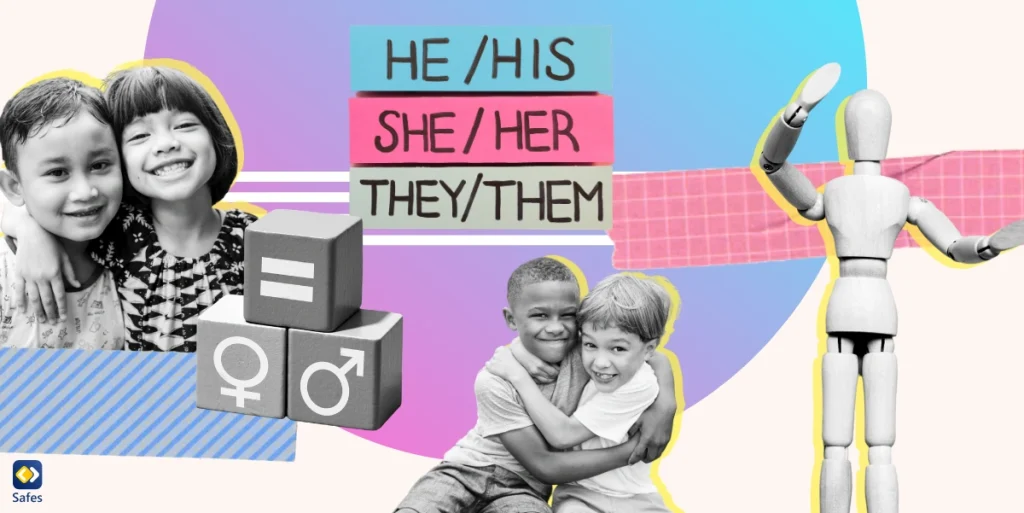What colors are associated with girls and what colors are associated with boys? There was a time when a girl’s favorite color had to be pink, and a boy’s favorite color had to be blue. Though we think we’ve moved past that, there are still many gender stereotypes that influence our daily lives. Sticking to the color example, many pregnant couples use these colors at gender-reveal parties. Nobody ever sees pink at a gender-reveal party and wonders what gender it specifies. Of course, this is a very harmless gender stereotype example. But more disturbing examples can be brought up, such as women being bad at driving, men not being allowed to cry in front of others, etc.
Raising children with such stereotypes in mind makes gender stereotypes, in general, second nature to them as they get older. This can lead to numerous undesirable consequences such as not embracing one’s own masculine or feminine traits, all deteriorating mental health in the long run. As parents, it is our responsibility to address these stereotypes and promote a more balanced upbringing for our children.
Read on to learn more about the nature of gender stereotypes, how they can harm your child, and how to prevent gender stereotyping in schools and society.
Understanding Gender Stereotypes
Gender stereotypes are commonly held, simplistic, and frequently strict beliefs or expectations about how various genders should behave, appear, or think. Based on cultural, social, and historical conventions, these stereotypes can lead to judgments and generalizations about persons depending on their gender. Gender stereotypes may be damaging because they restrict people’s freedom of expression and lead to discrimination and injustice. The following are some instances of prevalent gender stereotypes:
- Traditional Roles: Men, according to stereotypes, should be strong, forceful, and providers, whereas women should be caring and sensitive.
- Appearance: Gender stereotypes can include physical appearance, such as the assumption that women should wear long hair and cosmetics while males should wear short hair and avoid makeup.
- Occupations: Stereotypes can influence work decisions, with some people assuming that certain professions are better suited to one gender than another. For example, it is widely held that nursing is a “women’s career,” whereas engineering is a “men’s employment.”
- Emotions: Gender stereotypes may indicate that men should be stern and not display emotion or weakness, whereas women are expected to be more emotional and expressive.
- Toys and Activities: Toys and activities for children can be labeled as “for boys” or “for girls,” with some toys and games promoted as “for boys” or “for girls.” Action figures, for example, are frequently associated with guys, whereas dolls are sold to girls.
- Behavior: People of various genders are expected to behave differently in social circumstances. For example, women are stereotyped as being docile and courteous, whereas men might be more pushy and powerful.
- Sexuality: Stereotypes can also influence sexuality views, such as the belief that all males are naturally promiscuous or that women should be modest and reserved.

Gender Stereotyping in Early Childhood
Gender stereotypes may have a substantial influence on early childhood development since children are very impressionable and absorb gender signals from a young age. Here’s how gender stereotypes affect young children:
- Toy and Play Preferences: Children are frequently given gender-specific toys from infancy. Males could get action figures or vehicles, whilst girls would get dolls or kitchen sets. These early inclinations can define children’s interests while also limiting their exposure to a diverse variety of play situations. Boys, for example, may lose out on opportunities to develop caring and caregiving abilities, whilst females may avoid activities linked with STEM professions.
- Socialization: By their interactions with children, parents, caretakers, and other authority people frequently inadvertently promote gender stereotypes. They may urge boys to be “strong” and “self-sufficient,” while girls are encouraged to be “soft” and “helpful.” These messages have the potential to influence children’s actions and expectations of themselves and others.
- Media and Entertainment: At an early age, children are exposed to a wide range of media and entertainment. Through character depictions and narratives, these media frequently reinforce gender stereotypes. Male characters may be perceived as powerful and adventurous by boys, but female ones may be perceived as docile or in need of rescuing. These images have the potential to shape how youngsters view gender roles and actions.
- Peer Influence: Interactions between children and their classmates can also perpetuate gender stereotypes. They may feel compelled to adhere to what their peers consider “normal” gender behavior. If a youngster shows non-conforming interests or actions, this might lead to social rejection or scorn.
- Educational Expectations: Gender stereotypes may be unintentionally reinforced by teachers and educational resources. For example, guys may be pushed to thrive in math and science, but girls may be praised more for their reading and writing skills. These disparities in expectations can have an impact on children’s self-esteem and academic achievement. An example of gender stereotypes in education is that only boys are qualified for STEM fields.
How Gender Stereotypes Affect Child Development
Gender stereotypes have been shown in studies to have a harmful influence on children’s development. Strict gender stereotyping fosters inequality between the sexes and might prepare youngsters to expect and accept power inequalities in relationships and chances later in life. These can be either correct or incorrect. Stereotypes can have an impact on a person, a location, an object, or a circumstance.
The effects of gender stereotyping have been proven by research. According to GradesFixer, gender-stereotypic parenting in early infancy has a considerable impact in adulthood. People raised in conventional gender norms are more prone to have implicit gender stereotypes. They adhere to their own and others’ standards, perpetuating the cycle for decades.
Gender stereotypes can negatively affect children’s psychological, social, and emotional well-being in a variety of ways. Here are some of the ways that gender stereotypes can be harmful to children.
- Perpetuating Inequality: Stereotypes contribute to gender inequity by reinforcing established gender norms and expectations. Boys and girls may be given different opportunities, resources, and expectations, which can lead to lifetime differences in education, career, and social standing.
- Undermining Relationships: When children are reared with inflexible gender norms, it can have an impact on their future capacity to create healthy, equitable relationships. They may struggle to properly communicate or share duties in their personal and professional life.
- Reinforcing Gender-Based Violence: Stereotypes portraying boys and men as violent while portraying girls and women as meek can contribute to a culture of gender-based violence. It has the potential to propagate detrimental attitudes and actions that condone or justify violence against women and girls.

How to Stop Gender Stereotyping at Home
Eliminating gender stereotyping at home is a crucial step toward gender equality and creating a more inclusive and open-minded family atmosphere with enhanced cultural awareness in kids. These concrete methods can be used by teachers and parents to stop gender stereotyping in schools and homes, respectively:
- Open Communication: Establish a climate that encourages open and honest dialogues about gender. Make it clear to your children that they may communicate to you about their thoughts and experiences with gender without fear of being judged. Using parental controls such as Windows parental controls or a parental control app like Safes can help to structure conversations with your child by limiting their screen time, tracking their location and more. Safes is available on multiple platforms including iOS and Android. Start with Safes and sign up for a free trial to explore its parental control features.
- Challenge Your Own Biases: Consider your own gender-related thoughts and attitudes. Be open to admitting and challenging any prejudices or stereotypes you may have. See if you are deciding what toys to buy for your child based on bias. If so, consider purchasing interactive toys that are gender neutral.
- Address Stereotypes in Media: Point out examples of gender stereotypes in movies and TV shows and explain why they are problematic. Take advantage of these chances to teach your children about critical thinking. You can even talk about movies and books with gender stereotypes that turn the norms on their head.
Conclusion
Finally, overcoming gender stereotypes in children is an important duty for parents. It necessitates awareness, discussion, and action. Parental control applications can be useful tools in this journey, assisting parents in monitoring and guiding our children’s exposure to biased information. We can create a more inclusive and equitable environment for our children by aggressively addressing stereotypes at home.




